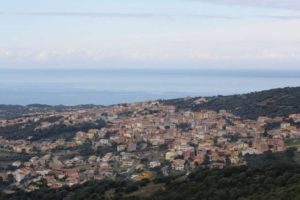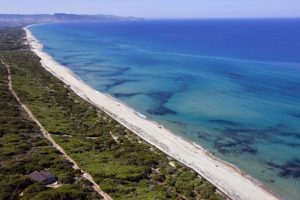 Badesi is a small coastal town in Gallura, facing the Golfo dell’Asinara in the North-West of Sardinia. Due to its prime location, the town enjoys the presence of thousands of visitors every year, attracted by the natural beauty and unspoiled landscapes that characterize the area. The town has three outlying villages, La Tozza, Muntiggioni and Azzagulta, not far from the centre. Badesi stands on a hill 102 metres above sea level and covers an area of about 35 sq. km. (40,96 Latitude – Longitude 8.88). There are about 1,900 inhabitants and they are called “Badesani”. The area offers visitors the chance to admire the landscape in many different guises: long beaches, nature reserves, broad valleys, rolling hills and granite plateaus.
Badesi is a small coastal town in Gallura, facing the Golfo dell’Asinara in the North-West of Sardinia. Due to its prime location, the town enjoys the presence of thousands of visitors every year, attracted by the natural beauty and unspoiled landscapes that characterize the area. The town has three outlying villages, La Tozza, Muntiggioni and Azzagulta, not far from the centre. Badesi stands on a hill 102 metres above sea level and covers an area of about 35 sq. km. (40,96 Latitude – Longitude 8.88). There are about 1,900 inhabitants and they are called “Badesani”. The area offers visitors the chance to admire the landscape in many different guises: long beaches, nature reserves, broad valleys, rolling hills and granite plateaus.
Badesi’s central location on the North-West coast of the Island means that it is easy to find and reach. The town is 16kms from Castelsardo along the S.P.90 Castelsardo – Santa Teresa di Gallura coast road, one of the main routes in the North of Sardinia which connects the two provinces of Sassari (SS) and Olbia -Tempio (OT).
The main Badesi town – Badesi seaside road junction from where you can enter the town or drive down to the sea, is marked by a roundabout which is a significant and useful starting point for getting to other tourist destinations in Sardinia. All the roads have ample signposting and the routes can be found using SatNav systems.
The sea at Badesi has its own unique colours and a beach that extends for over 8 kms, one of the longest in Sardinia. The Badesi coast enjoys a wild and solitary setting, and is bounded by dunes of fine white and golden sand, which are home to a variety of Mediterranean maquis and other vegetation. Closest to the sea are herbaceous flowering plants such as santolina, campion, sea lilies, sea knotgrass, sea holly, morning glory, stocks, bugloss and the sea rose, which is only found along the North coast of the island. further back, the denser vegetation includes herbaceous plants, shrubs and trees. Among the herbaceous plants is one known as the “buongiorno” plant, which comes from Africa as well as the astragalus. The shrubs include lentisk, or mastic, buckthorn, rock rose and yellow cistus.
Finally the larger trees and woody shrubs include the juniper, tamarisk and in the Baia delle Mimose area the mimosa, from which the area takes its name. Along the seashore the view is breathtaking: this stretch of coast goes from Castelsardo to the West as far as Isola Rossa to the East and on clear days you can see the islands of Asinara and Corsica. The Badesi coastline guarantees its visitors a safe and pleasant stay, while near the beach are a number of facilities ranging from places to eat and drink to sporting activities.
This long stretch of coastline is divided up into different sectors.
The beach at Li Junchi
The beach at Li Junchi is the main beach on the Badesi coastline. It has the highest number of bathers, and a large number of facilities: access with special equipment for handicapped users, medical station, beach umbrella and sun lounger hire, children’s playground, fee-paying parking, public swimming pool, Wi-Fi networks, a windsurfing school, life-guard service, bars, toilets with showers, tourist information service and library and local public transport shuttle bus service which connects the resort areas to the town. The beach at Li Junchi is also covered by the 118 Emergency Medical Service, with qualified staff ready to offer assistance both at sea and on the beach if necessary. Pets are not allowed.
The beach at Baia delle Mimose
Leaving the coast of San Pietro at Valledoria, the next beach is that of Baia delle Mimose. Thanks to its considerable length and the many paths from the car parks to the sea, this beach is rarely crowded, even in high season. There are essential services such as the hire of umbrellas, canoes and pedalòs, and a bar/restaurant. Car parking is charged for and the area is served by public transport shuttle buses, which connect Baia delle Mimose and the beach of Li Junchi with the town of Badesi.
Continuing towards the mouth of the river Coghinas , you will find the Dog Beach – Beach for dogs area. This service is provided over an area that covers 300 square metres of shoreline and 225 square metres of water. Access is allowed only to people with dogs, up to a maximum of 20, all of which should be registered. The creation of an area equipped and designed for dogs is aimed at countering the phenomenon of abandoned animals during the summer season. The service is offered by the Town of Badesi in partnership with the National Canine Defence League Alghero branch. Public toilets are also available.
The beach at Li Mindi (La Minda, probably indicating a former grazing area)
The beach at Li Mindi, a continuation of the beach at Li Junchi, is the furthest beach belonging to the Badesi coastline. This beach, well-known for being rarely visited and semi-wild, is ideal for those who do not like crowded environments. As with the beach at Li Junchi, Li Mindi is also covered by beach and sea rescue services, and the 118 Emergency Medical Service, with qualified staff ready to administer first aid and assistance both at sea and on the beach. Animals are not allowed on this stretch of beach, while additional amenities include parking (payment required) and public toilets.
The White Port or the Coal Port
After the Baia delle Mimose beach there is the Lu Poltu Biancu beach, also known as Lu Poltu di Lu Calboni, probably in reference to the port activities conducted here in ancient times. This stretch of coast is usually quiet throughout the summer season, free parking is guaranteed and pets are not allowed.
 The sea at Badesi has its own unique colours and a beach that extends for over 8 kms, one of the longest in Sardinia. The Badesi coast enjoys a wild and solitary setting, and is bounded by dunes of fine white and golden sand, which are home to a variety of Mediterranean maquis and other vegetation. Closest to the sea are herbaceous flowering plants such as santolina, campion, sea lilies, sea knotgrass, sea holly, morning glory, stocks, bugloss and the sea rose, which is only found along the North coast of the island. further back, the denser vegetation includes herbaceous plants, shrubs and trees. Among the herbaceous plants is one known as the “buongiorno” plant, which comes from Africa as well as the astragalus. The shrubs include lentisk, or mastic, buckthorn, rock rose and yellow cistus.
The sea at Badesi has its own unique colours and a beach that extends for over 8 kms, one of the longest in Sardinia. The Badesi coast enjoys a wild and solitary setting, and is bounded by dunes of fine white and golden sand, which are home to a variety of Mediterranean maquis and other vegetation. Closest to the sea are herbaceous flowering plants such as santolina, campion, sea lilies, sea knotgrass, sea holly, morning glory, stocks, bugloss and the sea rose, which is only found along the North coast of the island. further back, the denser vegetation includes herbaceous plants, shrubs and trees. Among the herbaceous plants is one known as the “buongiorno” plant, which comes from Africa as well as the astragalus. The shrubs include lentisk, or mastic, buckthorn, rock rose and yellow cistus.
Finally the larger trees and woody shrubs include the juniper, tamarisk and in the Baia delle Mimose area the mimosa, from which the area takes its name. Along the seashore the view is breathtaking: this stretch of coast goes from Castelsardo to the West as far as Isola Rossa to the East and on clear days you can see the islands of Asinara and Corsica. The Badesi coastline guarantees its visitors a safe and pleasant stay, while near the beach are a number of facilities ranging from places to eat and drink to sporting activities.
Badesi’s summer events begin with the three-day patron saint’s festival dedicated to the Sacro Cuore di Gesù which takes place in June. Other entertaining events continue in July and August with musical evenings, themed shows and food festivals. Gourmets should not miss the Sagra della zuppa gallurese, a traditional dish from Northern Sardinia while on August 10th , the night of San Lorenzo the “Calice sotto le Stelle” festival is held, an evening dedicated to tasting and enjoying wines and local produce.
Summer in Badesi is also well-known for its famous carnival which involves thousands of locals and tourists. Every August 13th for almost 30 years, floats and mask-wearing dancers parade through the central streets of the town. There are also numerous sporting events, such as meetings for surfing and kite surfing competitions and others which continue until September since the good weather and the number of visitors still encourage the organization of recreational activities.